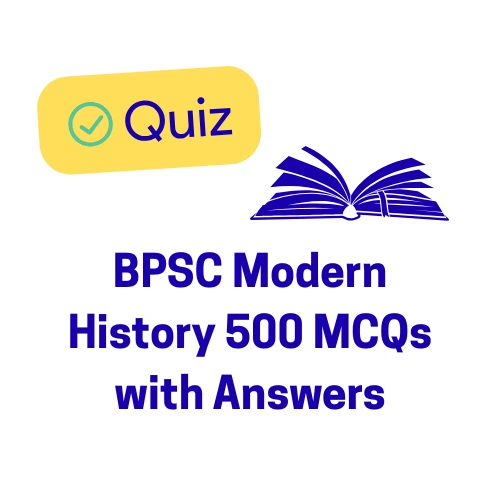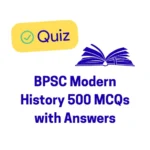BPSC Modern History Part 4 (500 MCQs) – focus on the Administrative Policies of British Governors-General (Cornwallis, Wellesley, Hastings), Judicial and Land Revenue Systems, and Social Legislation.
BPSC Modern History Part 4 (500 MCQs)
Section H: British Administrative and Judicial System
Q91. Who is famously known as the ‘Father of Civil Services in India’ for reforming and systemizing the administration?
(A) Warren Hastings
(B) Lord Wellesley
(C) Lord Cornwallis
(D) Lord William Bentinck
Q92. The Cornwallis Code (1793) introduced which of the following reforms?
Separation of revenue collection from the administration of justice.
Granting civil and military powers to the Collector.
Establishing the principle of ‘Supremacy of Law’ (Rule of Law).
(A) 1 and 2 only
(B) 2 and 3 only
(C) 1 and 3 only
(D) 1, 2, and 3
Q93. The first codification of laws in India, known as the Cornwallis Code, was primarily based on the principle of:
(A) Division of Powers
(B) Separation of Revenue and Justice
(C) Rule of Law
(D) Centralization of Authority
(E) More than one of the above
Q94. The judicial system under Lord Cornwallis was organized into a hierarchy of courts. Which of the following was the highest criminal court (in Bengal)?
(A) District Diwani Adalat
(B) Provincial Court of Appeal
(C) Sadar Diwani Adalat
(D) Sadar Nizamat Adalat
Q95. The Subsidiary Alliance System, which enabled the British to maintain a large army at the expense of Indian states, was primarily introduced by:
(A) Lord Cornwallis
(B) Lord Hastings
(C) Lord Wellesley
(D) Lord Dalhousie
BPSC Modern History Part 4 (500 MCQs)
Q96. Which state was the first to accept the Subsidiary Alliance system in 1798?
(A) Awadh
(B) Hyderabad
(C) Mysore
(D) Maratha Peshwa (Poona)
Q97. Who coined the term ‘Ring Fence Policy’ which was aimed at protecting the Company’s boundaries by creating buffer states against external threats?
(A) Robert Clive
(B) Lord Wellesley
(C) Warren Hastings
(D) Lord Cornwallis
Q98. Which Governor-General is credited with introducing the concept of establishing training colleges in India for the education of Company servants?
(A) Warren Hastings (Calcutta Madrasa)
(B) Lord Wellesley (Fort William College)
(C) Lord William Bentinck (Medical College, Calcutta)
(D) Lord Dalhousie (Roorkee Engineering College)
Q99. Lord Hastings’s administration (1813-1823) is associated with which of the following?
Conclusion of the Anglo-Nepal War (Treaty of Sagauli).
Suppression of the Pindaris.
The final defeat of the Maratha Confederacy (Third Anglo-Maratha War).
(A) 1 and 2 only
(B) 2 and 3 only
(C) 1 and 3 only
(D) 1, 2, and 3
Q100. Who was the British officer that signed the Treaty of Sagauli (1816), ending the Anglo-Nepal War?
(A) Sir John Shore
(B) Colonel Paris Bradshaw
(C) Lord Lake
(D) General Ochterlony
Section I: Land Revenue Systems
Q101. The Permanent Settlement (Zamindari System) of 1793 was introduced in which of the following regions
Bengal
Bihar
Orissa
Madras Presidency (Northern Circar)
(A) 1 and 2 only
(B) 1, 2, and 3 only
(C) 2, 3, and 4 only
(D) 1, 2, 3, and 4
Q102. The Permanent Settlement was introduced by Lord Cornwallis primarily to:
(A) Increase the agricultural production.
(B) Create a loyal class of landlords (Zamindars) who would support the British.
(C) Directly collect revenue from the peasants.
(D) Abolish the traditional village community system.
Q103. Under the Permanent Settlement, the Zamindars had to deposit the revenue to the state by sunset on a fixed day. This strict provision was known as:
(A) Ryotwari System
(B) Sunset Law
(C) Mahalwari System
(D) Tenancy Law
Q104. The Ryotwari System of land revenue, where the ownership rights were directly conferred on the cultivators (Ryots), was primarily introduced in:
(A) Bengal and Bihar
(B) North-West Provinces
(C) Madras and Bombay Presidencies
(D) Punjab
Q105. Who was the Governor of Madras who played a key role in the introduction of the Ryotwari System?
(A) Lord Cornwallis
(B) Thomas Munro
(C) Mountstuart Elphinstone
(D) John Shore
BPSC Modern History Part 4 (500 MCQs)
Q106. The Mahalwari System was introduced in the Ganga Valley, North-West Provinces, and parts of Central India. The settlement was made with which entity?
(A) Individual Zamindars
(B) Individual cultivators (Ryots)
(C) Village Community or Estate (Mahal)
(D) Provincial Governors
Q107. Which British officer proposed the Mahalwari System (introduced formally by Lord William Bentinck in 1833)?
(A) John Shore
(B) Holt Mackenzie
(C) James Grant Duff
(D) Mountstuart Elphinstone
Q108. The main difference between the Permanent Settlement and the Mahalwari System lay in:
(A) The percentage of revenue fixed.
(B) The authority responsible for collecting the revenue.
(C) The term of the settlement (permanent vs. temporary).
(D) The cultivation methods used by the peasants.
Q109. Which land revenue system was known for increasing the impoverishment and indebtedness of the peasants due to the direct tax demand by the state?
(A) Permanent Settlement
(B) Ryotwari System
(C) Mahalwari System
(D) All of the above
Q110. Under the Ryotwari System, the revenue assessment was generally revised after a period of:
(A) 5 years
(B) 10 years
(C) 30 years
(D) Permanently fixed
Section J: Reforms of Lord William Bentinck (1828-1835)
Q111. Lord William Bentinck is known for which of the following social reform acts?
(A) Abolition of Sati
(B) Abolition of the Practice of Female Infanticide
(C) Abolition of the Hindu Widows’ Remarriage
(D) Abolition of the Practice of Slavery
Q112. The abolition of Sati was primarily enforced with the active support of which prominent Indian reformer?
(A) Ishwar Chandra Vidyasagar
(B) Raja Ram Mohan Roy
(C) Swami Dayananda Saraswati
(D) Keshub Chandra Sen
Q113. The practice of Thuggee (ritualistic robbery and murder) was ruthlessly suppressed during the tenure of Lord William Bentinck by which officer?
(A) Colonel Sleeman
(B) Sir Charles Metcalfe
(C) John Lawrence
(D) Henry Lawrence
Q114. The Macaulay Minute (1835) proposed a shift in the medium of instruction in higher education in India from Oriental languages to:
(A) Hindi
(B) Persian
(C) English
(D) Sanskrit
Q115. Lord William Bentinck’s policy to promote Western science and literature through the medium of English led to the development of the theory known as:
(A) White Man’s Burden Theory
(B) Drain of Wealth Theory
(C) Filtration Theory (or Downward Filtration Theory)
(D) Educational Grant Theory
BPSC Modern History Part 4 (500 MCQs)
Q116. Who was the British Governor-General known as the ‘Liberator of the Press’ in India for repealing the licensing restrictions on the press?
(A) Lord William Bentinck
(B) Sir Charles Metcalfe
(C) Lord Macaulay
(D) Lord Auckland
Q117. Which city in South India was annexed by Lord William Bentinck on the ground of misgovernance in 1831?
(A) Tanjore
(B) Travancore
(C) Mysore
(D) Coorg
Q118. Which of the following constitutional acts was passed during the Governor-Generalship of Lord William Bentinck?
(A) Charter Act of 1813
(B) Charter Act of 1833
(C) Charter Act of 1853
(D) Indian Council Act of 1861
Q119. Lord William Bentinck carried out military reforms by abolishing which allowance given to the soldiers?
(A) Foreign Service Allowance
(B) Double Batta
(C) Field Allowance
(D) Dearness Allowance
Q120. Which Governor-General had the longest tenure among the following?
(A) Lord Cornwallis (1786–1793)
(B) Lord Wellesley (1798–1805)
(C) Lord Hastings (1813–1823)
(D) Lord William Bentinck (1828–1835)

